Text
going on a long hiatus.
hello everyone,
i know i haven't been active much recently to begin with, but i wanted to give a short notice before disappearing for a particularly long period of time without any explanation.
i'm going to be taking a long break from this site and many others, to focus on school/work and tend to my steadily declining mental health. i might do periodical check ins once in a while because at the moment i'm trying to sort out an issue with tumblr support, but otherwise my intent is to be fully logged out and away from here. save for any queued posts that were already scheduled in advance, i won't be posting anything new and i won't be responding to messages (asks & submissions are closed).
if anything urgent arises i can be contacted through discord but don't expect frequent responses.
i'm not sure when i'll be back, but i'll see you all again sometime, either when the hiatus is over, or in a rare intermittent post if i briefly break hiatus to make one (though the latter is unlikely). whatever the case, i'll update when i can.
thanks for your patience.
goodbye for now.
9 notes
·
View notes
Text
go be free
#references#??? idk if this really goes here but i have no idea where else i could put this.#just good ref that reminds me of how to do the changing to custom colors text thing cause i forget sometimes
966 notes
·
View notes
Text

#woke up in a cold fuckign sweat with a. fucked up idea (/pos???? idk actually??)#hougghh what do i do. idk if i have time to do anything but i also cant go back to sleep now. fuuuuckk#delete later
7 notes
·
View notes
Text
a glimpse for the mobile users who have no idea what theyre missing out on
#my video lol#i guess??#peep the new len theme guys 😎😎😎#SEE ITS 😭😭😭 YEAH CAUSE MY DESKTOP THEME LOOKS PRETTY NORMAL but for those stuck seeing just mobile layout its like. wtf#i found that len cursor by complete accident but then i knew what i had to do. i am free ive done character based themes before#nobody can stop my cringe. my blog my rules. PINK AGAIN YEAHAHHAHHH and len. again. lmao last year was halloween len now just. len?#SORRY ITS REALLY FUCKING FUNNY TO ME. i almost did this to main but i still really like the love cat theme there so i didnt wanna change it#ITS ALSO SUCH A FUNNY CONTRAST you have classy b&w over there. and then the most garish fucking pink imaginable over here#(well this desktop baby/hot pink isnt that bad. talking abt the mobile neonish pink)#og theme is by @/vitaminholland btw i just customized a few things like the colors cursor and added the search bar#ALSO ALSO I DIDNT REALIZE IT RECORDED THE MOUSE CLICK SOUNDS??? WHY IS IT SO LOUD HSKJGHJK
7 notes
·
View notes
Note
your header doesn't play a gif for me bc mine are turned off so it's just focused on lens chest I think that's unintentional lmao
😭😭😭
YEAH no not. intentional
its just this

#ask#ollie the star anon#i had to make this gif myself lmfao. christ its really big file size for some reason (prob all the colors) despite compression 💀#IT WAS ACTUALLY originally going to be the len from 1925 cause i also made a nice gif from that one#but i ultimately thought this was so much funnier so. 😭😭
5 notes
·
View notes
Text
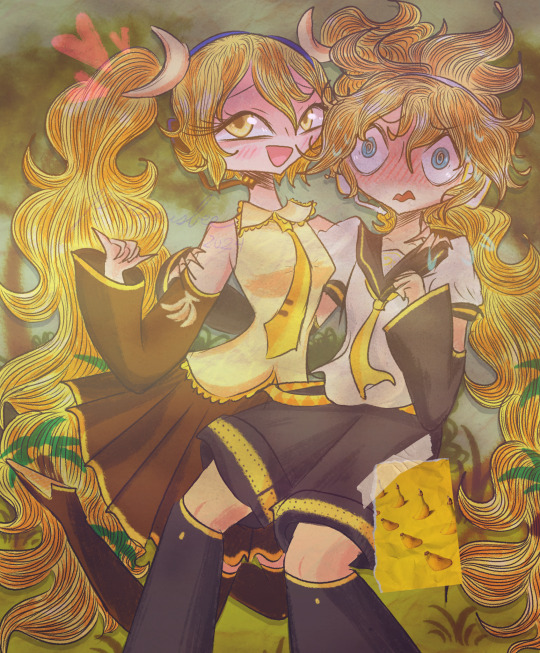
🌴 the perfect girl! 🍌

#my art lol#vocaloid#vocaloid fanart#kagamine len#len vocaloid#miku vocaloid#hatsune miku#banana miku#yellow#lenku#i guess???? that was the joke shkjghsk. cmon. banana miku and mr. resident banana lover. has anyone done this yet#the draft for this was technically sitting in my files since january; it was colored and lined and everything i was just too lazy#to finish properly shading & rendering it. im still not sure if i like how it came out but eh it is what it is#made it slightly less yellow by suggestion of my brother but only slightly. b/c part of the point of this was i wanted to draw smthn yellow#my laptop started lagging w/ the main drawing lmao 😭 and apparently firealpaca freaked out for no good reason doing the shitpost doodle#SO??? IS SOMETHING CURSED HERE? IDK MAN. ominous signs maybe given we ended last year w/ len and we're starting this year w/. len. again.#cant believe this is the first proper drawing of 2024 lmao... as much as i love drawing emo shit drawing smthn silly for a change is fun lo#idk what proper posting times are thats not real this is tumblr.
18 notes
·
View notes
Text


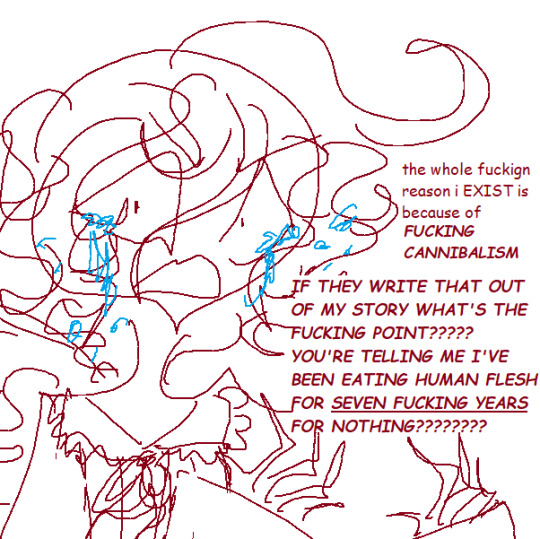
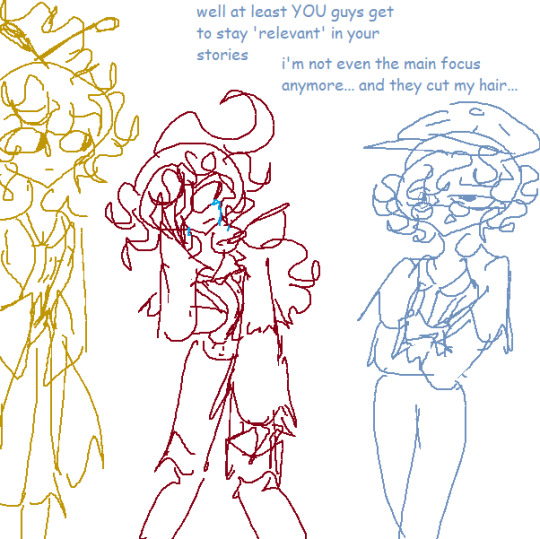
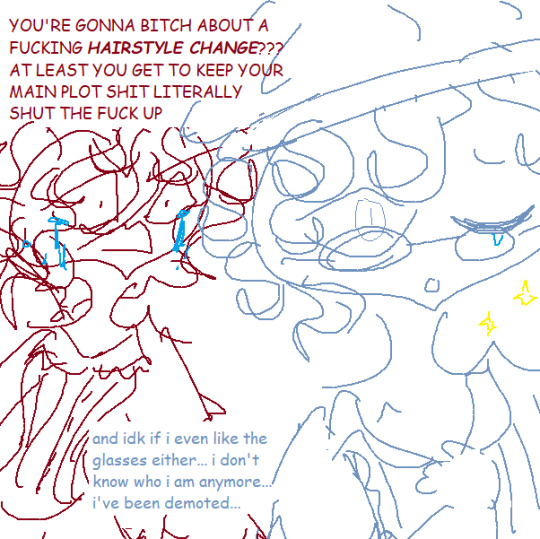
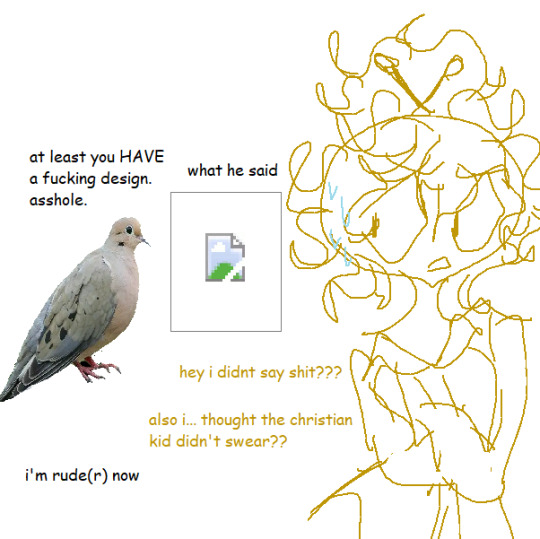
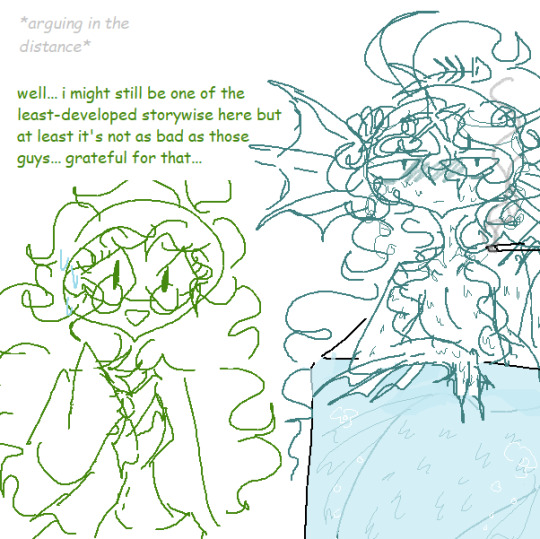



its called development hell for a reason
#my art lol#shitpost#comic#my ocs#do i really gotta tag all of them??? ugghh ok fine#aurelio#lucian#spencer#moira#legato#river#merth#dove and the other one arent getting tagged mostly b/c the other one doesnt have a [last] name yet even. fuckers#surprise. oc post. nobody [w/ exceptions] is gonna have like any idea wtf this means but that makes it funnier to me#NO THO DEADASS realizing some of these have technically been in devhell for. basically 6-7 years now. sheeesh. rip guys LMFAO#and theyre gonna stay in there for longer until i actually get shit together 😭 LMAO. chamomile's not even here b/c of that lmao#yknow what drawing smthn shitty and incomprehensible was kind of healing. i havent done ms paint shitposting in so long#not gonna say anything else. giggling to myself w/ my shitty sense of humor
4 notes
·
View notes
Text
hey artist
if you have a brain that really likes creating stuff, like
like u REALLY just love to make stuff,
I want you to know something.
this is very, very important
• you do not need to make something every day to still be an artist, it's okay to relax and enjoy things other people have made
• even if you don't finish your projects, they are still valuable
• big number on social media is the most painful thing to pursue and it relies heavily on luck and does not determine your worth
• you need to make art that isn't up to your artistic standards before you'll have the skills to create art you can be truly proud of
• drink some water. it's not related to being an artist but I know you're dehydrated.
13K notes
·
View notes
Text
Spent a long time on this art resource/reference masterpost! If you have a request for resources for me to find OR have a resource you want me to add, just send me an ask :D
General Anatomy/Human stuff:
body quick tips
painting/drawing straight hair
how to draw eyes
arm squish/bend tip
chest/pecks with raised arms tip
long hair how to
male torso anatomy (back)
learn manga male anatomy (torso & arm)
male torso anatomy (front)
head and hair tips (scroll a bit, it’s in one of the images!)
how to draw noses
ears tilty tip
arm tips
two tips for drawing women’s hair
drawing teeth
anatomy tips
random hair and mouth ref anime
leg muscle anatomy ref
arm muscles anatomy ref
knees reference
arm ref study
quick arm tut tip
how to draw arm
shoulders n sleeves
Poses:
umbrella poses
random female poses
random anatomy pose thing
chibi sleeping in hands pose
laying poses
elf (?) with staff poses
holding phone half bod
peeny wolf pose set
perspective pose sheet
anatomy poses
crossed arms ref sheet
holding baby poses
Hands:
how to draw hands 1
hand refs & tutorial 2
hand tutorial 3
hand tutorial 4
36 hands
how to draw hands in 10 minutes
hands ref 2
hand gestures and simplifying the hand
arm & hand ref
500 hands
Diversity:
stop drawing natives red
wheelchair tutorial
drawing fat people
vitiligo notes for artists
darkskin palms
epicanthic folds
biracial characters
do’s and don’ts of thick lips
Animals/Creatures:
how to draw falcon beaks
canine studies (broken down into parts)
feline tiger ref
Insect wing venation
Musculature of a T-Rex
Pony bodies tutorial
Hyena Nose tutorial
horse reference
drawing horns
Flesh tutorial
bird tips
wing basics
making mythical creatures look realistic
pony heads tutorial
dragon designing tutorial pt 3/3
pony wings tutorial
hedgie bodies
Furry/Anthro:
dogquest’s pixel tutorial
furry portrait tutorial
furry pants tutorial
how to draw paws/pawhands
fur direction reference
anthro tips
muzzle shapes
furry styles
anthro expressions
f2u chibi-ish furry base
furry / cartoon head tutorial
f2u furry base/pose w three different ears
drawing humans! for animal artists
Backgrounds:
how to draw debris
fire tutorial
night sky tutorial
materials study with notes
tree tutorial
water tutorial
tangents??
ocean painting
clouds tutorial
bubbles
painty background studies tips
peony tutorial
lakeside tutorial
quick flowers for the lazy
mistletoe vs holly
Perspective:
foreshortening coil technique
foreshortening tutorial
Webcomic:
medibang comic panel tutorial
how i make webcomics/webtoons
how to color comics
the art of lettering comics
comic/doujinshi paneling
in depth webcomic tutorial
Coloring:
72 Color Combinations
How ViPOP uses color
Hair coloring tutorial by rosuuri
Gurochii moe quick eye tutorial
Anime eye tutorial
Mermaid tail tutorial
Grayscale to Color painting tutorial
chibi eye walkthrough
skin tone tutorial 1
curly hair tutorial
color palette
coloring tutorial
light, it gets everywhere
comfort color
skin coloring tutorial
holographic tutorial
dappled lighting effect
cute/bright coloring tutorial
pattern trick
arcana character coloring tut
Expressions/ Meme / style:
small body language study
expressions reference
how to cute
Platonic cuddles meme
expression reference : nervous
flustered expression meme
drawing expressions tutorial/key
Pixel Art:
Pixel icon tutorial
Ice cream
Moving clouds tutorial
50x50 pixel doll tutorial
pixelin’s pixel process
pixel expression ref
pixel eye blinking tutorial
how to pixel liquids
Clothing / Accessories:
Shoes
Fancy color tip / ref
Chainmail
short reference
learn manga basic pleated skirt tutorial
learn manga basic frills
random clothing refs
chainmail brush
clothing ref masterpost
pinstripes tips
cloth texture tips
how to clothing folds
Misc:
Sketchfab 3d Models
Mikeymegamega on YT for anime/ecchi/etc
Gentei_sozai on twitter for chibi poses
S0zalsan on twitter for random poses
mecha basics
75 tutorials
Obvious art tips you might have forgotten
Mosaic effect
how to draw a cute chibi
fighting artblock
cute pikachu base
painting a face tutorial
volume commissions mini tutorial
arcana characters tutorial reference
notes from the “animators survival kit”
concept art tutorial
another art resource masterpost
MS paint tips and tricks
Reference table for drawing CONSISTENT faces
@hanari0716 on twitter for HELLA references
animation guide for beginners
Brushes:
Foliage brushes
cityscape brushes
ghibli brushes
clip studio paint assets
PS brush pack
24K notes
·
View notes
Text
Do Your Research
This phrase is regularly thrown around writeblr and for good reason. It's important to research what you are writing about to know what to include, what can be fudged, and how to depict whatever you're writing. I see "do your research" most thrown around by well-meaning and highly traditionally educated writers. It's solid advice, after all!
But how do you research?
For those writers who don't already have the research skills necessary to write something comfortably already downloaded into your brain, I put this guide together for you.
Where do I even start?
It's a daunting task, research. But the best place to start is with the most basic, stupidest question you can think of. I'm going to talk about something that I already know a lot about: fighting.
When researching fight scenes, a great way to start is to look up what different weapons are. There are tons out there! So ask the stupid questions. What is a sword? What is a gun? How heavy are they?
Google and Wikipedia can help you a lot with these basic-level questions. They aren't great sources for academic articles, but remember, this is fiction. It doesn't need to be perfect, and it doesn't need to be 100% accurate if you don't want it to be. But knowing what is true to life will help you write well. Just like knowing the rules of writing will help you break them.
You may find in your basic research sweep that you have a lot more specific questions. Write them all down. It doesn't matter if they seem obvious. Write them down because they will be useful later.
How To Use Wikipedia Correctly
Wikipedia is a testament to cooperative human knowledge. It's also easy to edit by anonymous users, which means there is a lot of room for inaccuracies and misleading information. Wikipedia is usually pretty good about flagging when a source is needed or when misleading language is obvious, but Wikipedia itself isn't always the most accurate or in-depth source.
Wikipedia is, however, an excellent collection of sources. When I'm researching a subject that I know nothing about, say Norse mythology, a good starting point is the Wikipedia page for Odin. You'll get a little background on Odin's name and Germanic roots, a little backstory on some of the stories, where they appear, and how they are told.
When you read one of the sentences, and it sparks a new question, write the question down, and then click on the superscript number. This will take you directly to the linked source for the stated fact. Click through to that source. Now you have the source where the claim was made. This source may not be a primary source, but a secondary source can still lead you to new discoveries and details that will help you.
By "source-hopping," you can find your way across the internet to different pieces of information more reliably. This information may repeat itself, but you will also find new sources and new avenues of information that can be just as useful.
You mean I don't need a library?
Use your library. Libraries in many parts of the US are free to join, and they have a wealth of information that can be easily downloaded online or accessed via hardcopy books.
You don't, however, need to read every source in the library for any given topic, and you certainly don't need to read the whole book. Academic books are different from fiction. Often their chapters are divided by topic and concept and not by chronological events like a history textbook.
For example, one of my favorite academic books about legislative policy and how policy is passed in the US, by John Kingdon, discusses multiple concepts. These concepts build off one another, but ultimately if you want to know about one specific concept, you can skip to that chapter. This is common in sociological academic books as well.
Going off of my Norse Mythology example in the last section, a book detailing the Norse deities and the stories connected to them will include chapters on each member of the major pantheon. But if I only care about Odin, I can focus on just the chapters about Odin.
Academic Articles and How To Read Them
I know you all know how to read. But learning how to read academic articles and books is a skill unto itself. It's one I didn't quite fully grasp until grad school. Learn to skim. When looking at articles published in journals that include original research, they tend to follow a set structure, and the order in which you read them is not obvious. At all.
Start with the abstract. This is a summary of the paper that will include, in about half a page to a page, the research question, hypothesis, methods/analysis, and conclusions. This abstract will help you determine if the answer to your question is even in this article. Are they asking the right question?
Next, read the research question and hypothesis. The hypothesis will include details about the theory and why the researcher thinks what they think. The literature review will go into much more depth about theories, what other people have done and said, and how that ties into the research of the present article. You don't need to read that just yet.
Skim the methods and analysis section. Look at every data table and graph included and try to find patterns yourself. You don't need to read every word of this section, especially if you don't understand a lot of the words and jargon used. Some key points to consider are: qualitative vs. quantitative data, sample size, confounding factors, and results.
(Some definitions for those of you who are unfamiliar with these terms. Qualitative data is data that cannot be quantified into a number. These are usually stories and anecdotes. Quantitative data is data that can be transferred into a numerical representation. You can't graph qualitative data (directly), but you can graph quantitative data. Sample size is the number of people or things counted (n when used in academic articles). Your sample size can indicate how generalizable your conclusions are. So pay attention. Did the author interview 300 subjects? Or 30? There will be a difference. A confounding factor is a factor that may affect the working theory. An example of a theory would be "increasing LGBTQ resources in a neighborhood would decrease LGBTQ hate crimes in that area." A confounding factor would be "increased reporting of hate crimes in the area." The theory, including the confounding factor, would look like "increasing LGBTQ resources in a neighborhood would increase the reporting of hate crimes in the area, which increases the number of hate crimes measured in that area." The confounding factor changes the outcome because it is a factor not considered in the original theory. When looking at research, see if you can think of anything that may change the theory based on how that factor interacts with the broader concept. Finally, the results are different from the conclusions. The results tell you what the methods spit out. Analysis tells you what the results say, and conclusions tell you what generalizations can be made based on the analysis.)
Next, read the conclusion section. This section will tell you what general conclusions can be made from the information found in the paper. This will tell you what the author found in their research.
Finally, once you've done all that, go back to the literature review section. You don't have to read it necessarily, but reading it will give you an idea of what is in each sourced paper. Take note of the authors and papers sourced in the literature review and repeat the process on those papers. You will get a wide variety of expert opinions on whatever concept or niche you're researching.
Starting to notice a pattern?
My research methods may not necessarily work for everybody, but they are pretty standard practice. You may notice that throughout this guide, I've told you to "source-hop" or follow the sources cited in whatever source you find first. This is incredibly important. You need to know who people are citing when they make claims.
This guide focused on secondary sources for most of the guide. Primary sources are slightly different. Primary sources require understanding the person who created the source, who they were, and their motivations. You also may need to do a little digging into what certain words or phrases meant at the time it was written based on what you are researching. The Prose Edda, for example, is a telling of the Norse mythology stories written by an Icelandic historian in the 13th century. If you do not speak the language spoken in Iceland in 1232, you probably won't be able to read anything close to the original document. In fact, the document was lost for about 300 years. Now there are translations, and those translations are as close to the primary source you can get on Norse Mythology. But even then, you are reading through several veils of translation. Take these things into account when analyzing primary documents.
Research Takes Practice
You won't get everything you need to know immediately. And researching subjects you have no background knowledge of can be daunting, confusing, and frustrating. It takes practice. I learned how to research through higher formal education. But you don't need a degree to write, so why should you need a degree to collect information? I genuinely hope this guide helps others peel away some of the confusion and frustration so they can collect knowledge as voraciously as I do.
– Indy
2K notes
·
View notes
Text

#art meme#is that the tag?? i dont remember shit on here anymore#anyways ive been seeing this and the CONCEPT is really funny giggling#only thing i can think of for mine atm is 'round' b/c ik i use a lot of sharp shapes in my stuff and I LIKE IT LIKE THATT#i suck at drawing soft/round shit 😭😭 everything gotta b POINTY!! GIMME THOSE SHARP EDGES
1K notes
·
View notes
Text
more experiments in trying to make vsynths sound distressed
#my audio lol#actually not gonna tag this w/ anything else b/c fuck it. just a test not meant to b anything noteworthy#in case u cant tell what hes saying:#'they're not coming back for us... we're gonna die here!'#where tf is he?? who's he talking abt?? use your imagination
12 notes
·
View notes
Text
people NEED to stop gatekeeping making music like ohhhh i don’t have an instrument ohhhhh i don’t know music theory ohhhhh i’m not gonna pay for some program. SHUT UP. take my hand.
you need NONE of that shit!!!!! there’s a website called beepbox.co. literally all you have to do is press things until it sounds a modicum of nice. it’s easy it’s free and it works on anything which has a browser because it’s a website.

if even ONE person starts making music bc of this post it will be worth it.
making bad music is just as important and okay as it is to write badly or draw badly or sing badly. you AREN’T BEHOLDEN TO MAKE GOOD MUSIC. making music is not utilitarian HAVE FUN. HAVE FUN!!!!!!!!!
#resources#??????? idk what else to tag this i dont remember if ive rbed anything music related here
51K notes
·
View notes
Text
What is Tragedy Exploitation?
Tragedy exploitation is the fixation on the traumatic elements of a marginalized group’s past and/or present. Such narratives are often promoted due to the misguided belief that the more painful a story, the more meaningful.
Within the publishing industry, the reality is that stories focusing on the tragedy of man’s internal conflict are heavily lauded, but this takes on a different dimension when an author is an outsider depicting stories that feature underrepresented groups.
In a media landscape where stories of marginalized suffering receive disproportionate visibility and acclaim, what a number of marginalized audiences need more are stories of hope and empowerment rather than tragedy.
Further Reading:
White Authors and Topics to Avoid/Tread Carefully
Writing About PoC Trials and Tribulations
Tragedy Exploitation and Characters of Color (follow up)
Avoiding Tragedy Exploitation - Craft Aspects to Consider
---
This Q&A is an excerpt from our General FAQ for Newcomers, which can be found in our new Masterpost of rules and FAQs. Take a look for more resources on diverse representation.
-Writing With Color
2K notes
·
View notes
Text
HOW TO GIVE PERSONALITY TO A CHARACTER
Giving personality to a character is an essential part of character development in storytelling, whether you're writing a novel, screenplay, or creating a character for a role-playing game. Here are some steps and considerations to help you give personality to your character:
Understand Their Backstory:
Start by creating a detailed backstory for your character. Where were they born? What were their childhood experiences like? What significant events have shaped their life? Understanding their past can help you determine their motivations, fears, and desires.
2. Define Their Goals and Motivations:
Characters often become more interesting when they have clear goals and motivations. What does your character want? It could be something tangible like a job or a romantic relationship, or it could be an abstract desire like happiness or freedom.
3. Determine Their Strengths and Weaknesses:
No one is perfect, and characters should reflect this. Identify your character's strengths and weaknesses. This can include physical abilities, intellectual skills, and personality traits. Flaws can make characters relatable and three-dimensional.
4. Consider Their Personality Traits:
Think about your character's personality traits. Are they introverted or extroverted? Shy or outgoing? Kind or selfish? Create a list of traits that describe their character. You can use personality frameworks like the Myers-Briggs Type Indicator or the Big Five Personality Traits as a starting point.
5. Give Them Quirks and Habits:
Quirks and habits can make a character memorable. Do they have a specific way of speaking, a unique fashion style, or an unusual hobby? These details can help bring your character to life.
6. Explore Their Relationships:
Characters don't exist in isolation. Consider how your character interacts with others. What are their relationships like with family, friends, and enemies? These relationships can reveal a lot about their personality.
7. Show, Don't Tell:
Instead of explicitly telling the audience about your character's personality, show it through their actions, dialogue, and decisions. Let the reader or viewer infer their traits based on their behavior.
8. Create Internal Conflict:
Characters with internal conflicts are often more engaging. What inner struggles does your character face? These can be related to their goals, values, or past experiences.
9. Use Character Arcs:
Consider how your character will change or grow throughout the story. Character development is often about how a character evolves in response to the events and challenges they face.
10. Seek Inspiration:
Draw inspiration from real people, other fictional characters, or even historical figures. Study how people with similar traits and backgrounds behave to inform your character's actions and reactions.
11. Write Dialogue and Inner Monologues:
Writing dialogue and inner monologues from your character's perspective can help you get inside their head and understand their thought processes and emotions.
12. Consider the Setting:
The setting of your story can influence your character's personality. For example, a character who grows up in a war-torn environment may have a different personality than one raised in a peaceful, affluent society.
13. Revise and Refine:
Don't be afraid to revise and refine your character as you write and develop your story. Characters can evolve and change as the narrative unfolds.
Remember that well-developed characters are dynamic and multi-faceted. They should feel like real people with strengths, weaknesses, and complexities. As you write and develop your character, put yourself in their shoes and think about how they would react to various situations. This will help you create a compelling and believable personality for your character.
11K notes
·
View notes
Text
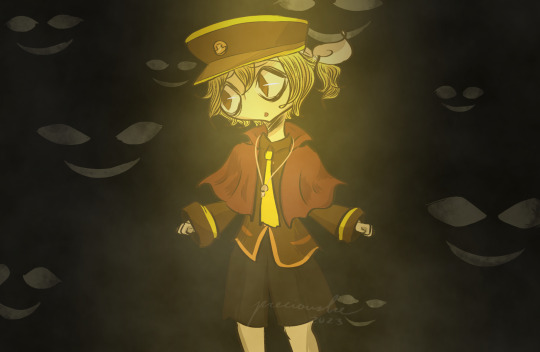

screenshot redraw
#my art lol#vocaloid#vocaloid fanart#kagamine len#len vocaloid#conductor vermilion#1925 vocaloid#project diva#idk what else to tag this with lmao.#the last len of 2023... or ig depending on your timezone first len of 2024???#the last drawing of this year for me was supposed to be something else but i kinda gave up on it :/#this was originally just a warmup that i wasnt gonna post since its not very good but. ¯\_(ツ)_/¯
28 notes
·
View notes
